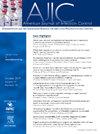Successful practices to reduce central line–associated bloodstream infections post pandemic: A qualitative study
IF 3.8
3区 医学
Q2 INFECTIOUS DISEASES
引用次数: 0
Abstract
Background
Central Line-Associated Bloodstream Infections (CLABSIs) decreased in U.S. hospitals over the last decade, but CLABSI rates increased during the COVID-19 pandemic disrupting the downward trend. This study explored factors contributing to the reduction of CLABSI, identifying deviations in infection prevention and control protocol during the pandemic, actions taken to address the increase in CLABSI, and factors promoting sustained progress.
Methods
This qualitative study used the National Healthcare Safety Network data. The Centers for Disease Control and Prevention identified hospitals with elevated CLABSI standardized infection ratios (SIR) >1 between Q1 2019 – Q4 2021 followed by four quarters of sustained reduction (CLABSI SIR <1). Joint Commission researchers conducted semi-structured phone interviews with infection preventionist professionals from six hospitals representing these performance patterns.
Results
Interview themes suggested that staffing shortages (83%) and less vigilant central line practices (100%) contributed to increased CLABSI SIR during the pandemic. Organizations described evidence-based interventions, such as using chlorhexidine gluconate for skin preparation, along with other innovative strategies they used to establish reduced CLABSI rates.
Conclusions
Despite challenges faced during the COVID-19 pandemic, some health care organizations have excelled in their efforts to reduce and sustain low rates of CLABSI by implementing evidence-based practices, innovative solutions, and education.
减少大流行后中心静脉相关血流感染的成功实践:定性研究
背景过去十年间,美国医院的中心静脉相关血流感染(CLABSIs)有所下降,但在 COVID-19 大流行期间,CLABSI 感染率有所上升,打破了下降趋势。本研究探讨了导致 CLABSI 下降的因素,确定了大流行期间感染预防和控制规程的偏差、为应对 CLABSI 上升而采取的措施以及促进持续进步的因素。美国疾病控制与预防中心确定了在2019年第一季度至2021年第四季度期间CLABSI标准化感染率(SIR)升高并持续四个季度下降(CLABSI SIR <1)的医院。联合委员会的研究人员对代表这些绩效模式的六家医院的感染预防专家进行了半结构化电话访谈。结果访谈主题表明,人员短缺(83%)和中央管路操作警惕性较低(100%)是导致大流行期间CLABSI SIR增加的原因。尽管在 COVID-19 大流行期间面临挑战,但一些医疗机构通过实施循证实践、创新解决方案和教育,在降低和维持低 CLABSI 感染率方面表现出色。
本文章由计算机程序翻译,如有差异,请以英文原文为准。
求助全文
约1分钟内获得全文
求助全文
来源期刊
CiteScore
7.40
自引率
4.10%
发文量
479
审稿时长
24 days
期刊介绍:
AJIC covers key topics and issues in infection control and epidemiology. Infection control professionals, including physicians, nurses, and epidemiologists, rely on AJIC for peer-reviewed articles covering clinical topics as well as original research. As the official publication of the Association for Professionals in Infection Control and Epidemiology (APIC)

 求助内容:
求助内容: 应助结果提醒方式:
应助结果提醒方式:


